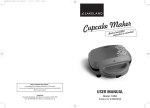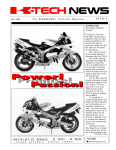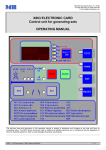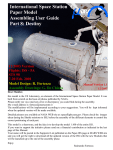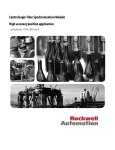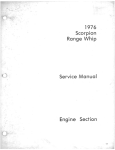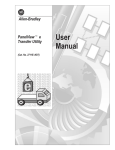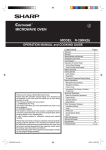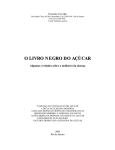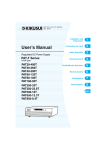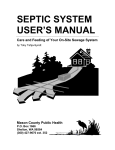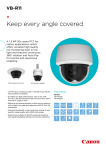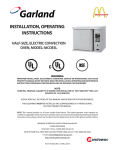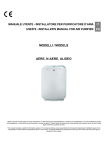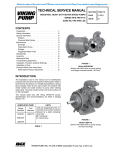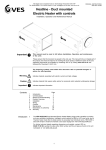Download 2F-440-3 Service Manual
Transcript
SVM-7735 Service Manual I For G) JLO Axial-Fan Twin Cylinder Engine Model LR-440/2 (2F-440-3) • 2-CYCLE ENGINE FUNDAMENTALS · • ENGINE BREAK-IN • EXHAUST SYSTEMS • DISASSEMBLY AND ASSEMBLY INSTRUCTIONS OF BASIC ENGINE INCLUDING RECOIL STARTER • ELECTRIC STARTER MOUNTING INSTRUCTIONS • IGNITION TIMING PROCEDURE • SPARE PARTS LIST; SERVICE TOOLS I 2-Cycle Engine Fundamentals The 2-cycle, air-cooled gasoline engine has become very popular today for snowmobi les, ATV's and other recreational vehicles. It is uniquely qualified for these applications because of its relatively high power output, light weight, and ease of lubrication, with fewer moving parts than conventional 4-cycle engines. However, in order to get the best possible use, and assure that it retains its high degree of dependability and endurance, it must receive proper care and maintenance. Since the life expectancy of any 2-cycle gasoline engine depends to a great degree on the level of maintenance it receives, it is necessary for us to know something about the basic fundamentals of an engine and how it functions in order to determine and apply, the correct amount of maintenance. Operation The JLO 2-cycle engine is of the loop-scavenged, 3rd-port design type ... the most widely used design today. It uses a mixture of gasoline and oi l for combustion, lubrication and cooling. It f ires on every stroke of each piston. There are two power strokes for every revolution of the crankshaft. As the piston moves upward in the cylinder (Illustration A), it draws the fuel/air mixture into the lower crankcase while at the same time compressing the fuel already in the compression chamber above. As the piston nears T.D.C., the spark plug ignites the compressed fuel and the burning fuel expands and forces the piston downward on its second, or power stroke (Illustration B). In this downward stroke the piston not only turns the crankshaft but compresses a new charge of fuel in the crankcase while continuing downward clearing the exhaust ports (Illustration C) in the cylinder wall to release the burned gasses through the ports and out into the exhaust system. The piston continues downward to uncover the transfer port and release the compressed fuel charge into the cyl inder where it displaces the remaining burned gasses and forces them out through the exhaust ports (Il lustration D). Because lubrication of 2-cycle engines depends on mixing predetermined amounts of oil and fuel, it is extremely important that good quality oil be thoroughly mixed with fuel and in proper proportions. Whi le there are different engines, as well as different oils, requiring different fuel mixtures, the correct oil-fuel ratio required for Rockweii-JLO engines is 20 to 1. Use of little oil may cause engine over-heating, piston or cylinder scoring and eventual engine seizure or failure. Too much oil, on the other hand, leads to incomplete combustion, carbon fouling of plugs and piston overload. ... TRANSFER INTAKE EXHAUST A B 2 D· C> Carburetion Spark Plug In order to atomize the oil-fuel mixture and mix it with proper proportions of air flowing to the intake port or intake manifold, it is necessary to utilize a carburetor. Carburetor design is based on the venturi principle whereby a gas or liquid flowing through a restricted or necked-down passage increases in velocity and decreases in pressure as compared to the velocity and pressure in the full size section of the passage. The spark plug provides the electric spark necessary for ignition of the compressed fuel-air mixture in the cylinder. There are many types and sizes of spark plugs, depending on engine design and operating characteristics. Most single cylinder, 2-cycle engines use the "short reach " type spark plug, while the newer, angled-head single and twin cylinder engines use the "long reach" type spark plug. The most commonly used thread sizes are 10 mm., 14 mm. and 18 mm. Spark plugs tip temperatures are also extremely important in proper engine operation , therefore, they should be selected according to engine design and type of service There are various types of carburetors classified by method of delivery of fuel to the carburetor: float, suction lift and diaphragm type. JLO Engines mainly use diaphragm type carburetors , therefore, future references herein will be limited to this type of carburetor. Courtesy of Walb ro Carburetor Corp. Terminal nut Insulator Terminal bolt Courtesy of Tillotson Mfg. Co. Crimping ring Ignition Gasket seal The ignition system provides the high voltage electrical energy which flows across the spark plug electrode gap to create ignition spark. Most small engines are equipped with magneto type ignition. The magneto ignition system generates and transforms electrical energy into high voltage, delivering it at the proper time for ignition spark. Center electrode Screw thread Ground electrode Courtesy of Robert B osch. GMBH . Flywheel Magneto Armature plate G enerator armature for ignition Flyweight for ignition timing adjustment Courtesy o f R o b e rt Bosc h . G MBH. Oxide magnet with pale shoe Starting, Stopping, Fuel Mixture Starting Procedure 1. Turn switch to "on" position. 2. Close choke (warm engine requires little or no choking). 3. Open throttle slightly when cranking the engine. 4. As soon as the engine starts open choke and release throttle. 5. Electric start: Turn switch to "start" position. Release as soon as the engine starts (switch will remain in "on" position). Do not continue cranking the engine if it fails to start after approximately 30 seconds. Allow the starter to cool before making another attempt. If the battery is low use the recoil starter. Operation Before operating at full load, let engine warm up for a few minutes. Idling Do not let the engine idle for prolonged periods as this may result in carbon build-up, foul the spark plug or cause flooding. Engines put under severe strain, may continue running after the ignition is turned off. To stop the engine under these • conditions, shut off the air supply by closing the choke. Stopping Procedure Release the throttle to allow engine to idle. Turn switch to "off" position. Do not use the choke to stop the engine. This can result in carburetor flooding, making it very difficult to restart. Safety Precautions 1. Never add fuel while the engine is running as spilled fuel might ignite on contact with hot engine su rfaces. Stop engine and allow to cool. 2. Always be sure .ignition switch is in "off' position before working on engine. 3. Make sure all safety shields or guards on engine and driven equipment are in proper position and secu rely fastened . 4. When starting, keep hands, feet and clothing at a safe distance from moving parts. 5. Do not operate the engine in closed buildings unless exhaust pipe is vented to the exterior. 4 Fuel Mixture Gasoline Required Gas/Oil Ratio Ounces Of Oil 20 to 1 32 5 Gallons 20 to 1 26 4 Gallons 20 to 1 19 3 Gallons 20 to 1 13 2 Gallons 20 to 1 6.5 1 Gallon NOTE: Mix gasoline (90 octane minimum), with SA E 30-40 air-cooled engine oil. Premix thoroughly before pouring into vehicle tank by first mixing 1 gallon of gasoline with all the oil, shaking vigorously and then adding the rest of the gasoline. Always use fresh, clean gasoline to avoid gumming up or clogging the carburetor. Volume Equivalents 1 U.S. Quart = .946 Liters 1 U.S. Quart = .833 Imperial Quart 1 U.S. Quart = 1 U.S. Quart = 32 Ounces 2 U.S. Pints 0 Exhaust Systems Tuned Mufflers, Expansion Chambers Selection Selection of an exhaust system (including exhaust manifold, interm ediate pipes, elbows and muffler), is a result of thorou gh test procedures involving measurement of fuel consumption, horsepower and noise level. Contrary to popular belief, the exhaust system is not only for quieting the engine, but also serves to increase the horsepower output (by as much as 25%). Changes made to the original equipment exhaust system by changing any component in the system can result in loss of power and/ or severe engine damage. For these reasons, intermediate lengths of pipe between the cylinder and the muffler are particul arly critical. back into the cylinder using sound waves and sound energy. This is accomplished at the speed of sound which allows the engine to produce higher torque at high RPM 's. How Tuning Works The megaphone effect of the expanded intake tube scavenges exhaust gas from the cylinder, allowing rapid replacement of the fuel-air mixture from the crankcase. Reflected sound waves and sound energy stop overscavenging and return fuel-air mixture to the cylinder. It gives a "super-charg ing" effect even though it operates from the exhaust rather than the intake side. Over-scavenging is also retarded by moderate muffler back pressu re. Silencing is accomplished after power is maximized, by Tuned Mufflers acoustical packing in the resonator outlet tube plus chamTuned mufflers allow the engine to exhaust its spent charge bering and baffling which gives an effective 2-pass muffler into an adequate volume and properly matched muffling design. system. More important, the mufflers are "tuned ", incorporate designs that "suck" the exhaust gas from the cylinder Racing Expansion Chambers allowing fuel and air to rapidly replace it and also "cram ·· Expansion chamber incorporates power-tuning to increase over-scavenged fuel and air mixture from the exhaust pipe horsepower of two-cycle engines up to 25 per cent. Typical Exhaust Systems ACS Donaldson Tuning Co urtesy of D on ald so n Muffi e r Co . Expansion Chamber (Racing) f)JLO Twin Cylinder Engines Disassembly and Assembly Procedure - Model LR-440/2 (2F-440-3) Disassembly A. Recoil Starter Remove four screws holding recoi l to fan housing and the spacers and washers. Remove recoil assembly, complete. (For detailed service instructions refer to Recoil Starter, Disassembly and Assembly}. A B - ~ ~ B. Lower Fan Pulley and Carrier Assembly Remove three hexhead screws on carrier. Remove dust seal, carrier, lower pulley halves and V-belt. C. Upper Fan Belt Pulley Assembly To keep impeller from turning, insert a punch through the fan housing and into the impeller body. With a 17 mm . wrench, remove fan nut. Pull out the loosened assemblynut, washer, spacers, and upper pulley halves. D. Flywheel Magneto Make sure spark plugs are tight. Working against engine compression, w ith a 27 mm. wrench, remove crankshaft nut by striking wrench a few sharp blows with a hammer. To pull flywheel, attach special puller to flywheel flange, using three of the recoil starter screws previously removed . Screw into the three holes on flange and tighten . Turn puller until bolt touches tip of crankshaft. With a 24 mm. socket wrench, turn puller bolt clockwise and extract flywheel. Note that key may come loose and adhere to the flywheel magnets. ~. ~> c D ~ E. Intake Manifold Remove the four nuts holding manifold and upper coil cover, plus the two lower coil cover screws. Remove screw holding spark plug wire to side of fan housing. F. Fan Housing; Armature Plate With a special Allen Head wrench, remove t he 4 socket cap screws holding fan housing to crankcase. To loosen, place unit with fan housi[lg protrud ing over end of workbench and, holding housing with one hand, hit light but sharp blows around periphery. Pull housing straight out past the crankshaft careful not to cut the oil seal on the sharp edges of keyway of the shaft. Disconnect solid blue and blue-yellow coil wires and remove entire assembly. The armature plate is attached to the fan housing by two slotted screws and can be removed at this time. Scratch-mark its original position before removal as this will facilitate engine timing. Impeller assembly should come loose and may be removed at same time as fan housing assembly. The fan housing bearings can be removed at this time, if necessary, by punching out from the side opposite that from which they are normally inserted. 6 D F 0 F F c G. Spark Plugs Remove with special socket wrench. H. Cylinder Heads Remove the 17 mm. head nuts and lift head and gasket from cylinder block. Mark cylinder head and corresponding cylinder in order to assure proper reassembly. (Cylinder c losest to the P.T.O. end is always considered No. 1 cylinder.) Repeat operation for second cylinder. I. Cylinders Lay unit on end and with a 13 mm. socket remove the 8 cylinder-base nuts. (Unless complete disassembly is required, remove one cylinder at a time so as to maintain crankcase alignment.) Set unit upright again and lightly tap cylinder with a rubber hammer and lift gently until piston clears the skirt. Repeat operation for second cylinder. J. Piston and Wrist Pin Prior to removing mark each piston in relation to the cylinder with which it mates. With needle-nose pliers or special screwdriver remove the two different circlips on each side of wrist pin. Gently drive out wrist pin. Repeat operation for piston No. 2. K. Crankcase To separate cran kcase halves, hold upper shell w ith left · hand and " rock" slightly back and forth to break the sealing surfaces. If necessary, strike side of crankcase with rubber hammer to complete the separation. Remove crankshaft. L. Crankshaft; Crankshaft bearings With crankshaft on work surface, remove oil seal and alignment washer from P.T.O. end. To remove bearings use special puller. Slide puller body over crankshaft and align bolt with cran kshaft end. Slip puller half-shells around the bearing and engage them on puller grooves. Slide retaining ring over half-shells to keep them on the bearing. Using two 27 mm. wrenches, turn puller center bolt with one wrench while holding puller body with the other. Keep turning puller center bolt clockwise until it pulls the bearing to the end of the crankshaft. J J K K l l 7 0JLO Twin Cylinder Engines Disassembly and Assembly Procedure- Model LR-440/2 (2F-440-3) Assembly 1. Crankshaft Heat crankshaft bearings in oil preheated to 180° F. After reaching temperature, quickly slip bearing over end of crankshaft; it should fall freely on the counterweight. Using a hollow pipe with a diameter approximately that of the inner bearing race, hit pipe with a rubber hammer and seat the bearing on the shaft. The bearing should now rest securely and turn freely. Repeat pro1 cedure for bearing on other end of c rankshaft. 2. Crankcase Inspect both halves of crankcase and clean carefully removing any left-over adhesive or burrs. Apply Permatex type sealing compound to lower crankcase shell sealing surfaces and a little on the bearing surfaces. Note that no seal gaskets are used. Place crankshaft in lower shell and align spacers with machined grooves. Place oil seal on P.T.O. end of shaft flush with the casting. Turn crankshaft with your hand to check freedom of movement and make sure that the oil seal is seated. Install upper crankcase shell and seat by tapping it lightly. - 2 2 2 3. Piston and Cylinder Clean carbon deposits from the piston. Check to see that rings move freely in their grooves. Mate piston with corresponding cylinder. The piston must be installed with the arrow pointing toward the exhaust port. Insert needle bearir}gs into the connecting rod, then place a daub of grease on the connecting rod so that the spacers installed later will adhere to it. Gently guide the piston over the connecting rod and insert the wrist pin. Snap circlips into each side of the piston using a screwdriver or needle-nose pliers. Install cylinder base gasket. Place a V-shaped wood block under the piston, resting it on the crankcase. After lining up the rings with the locating pins on the piston, compress them with a ring compressor. Rest the piston on the wood block and carefully slide the cylinder over the piston until the rings disappear i.nto the cylinder. Be sure you use a gasket of the same color as was removed from the engine because there are four gaskets available having different thicknesses. Note that the top of the piston must be within ± 0. 008" of the top of the cylinder. Use a gasket whj ch will achieve this result.. Mark the dimension on the cylinder in pencil. Remove ring compressor and wood block. Repeat procedure for second cyl inder. Turn the unit over on its side and install the cylinder base nuts and tighten lightly. Assemble the intake man ifold and tighten the four screws. Draw nuts tightly in order to evenly align both cylinders. Turn unit completely over (upside down) and torquedown the cylinder base nuts to specifications in a crosswise pattern. Remove the inlet manifold assembly (previously installed only to align the cylinders). 4. Impeller; Fan Housing Bearings Install fan housing spacer and circlips- (one circlip on each side.) Pack fan housing opening with bearing grease and 8 3 3 c c insert bearings-one on each side, with sealed surfaces facing outward. Sl ide shaft thru impeller and install N ilos ring on the side of the impeller wh ich faces the housing, and then thru the bearings. 5. Fan Housing; Armature Plate Install the armature plate aligning it with the scratch marks previously put on during disassembly. Tighten slotted screws. Check the wiring protruding from the fan hou sing to make sure that there are no broken wires. Slip the rubber grommet protecting the wires into the housing. Check the 0 -rin g on the back side of t he fan housing and the oil seal for c uts or other visible damage. Pass the fan housing over the crankshaft and avoid hitting the sharp edges of the keyway. Adjust the housing against the crankcase and insert the four screws with the special Allen Head tool. Tighten Allen Head Screws in crosswise pattern. 6. Intake Manifold; Coil Cover Install intake manifold assembly and gasket; tighten the two upper manifo ld nuts. Connect the ignition coil wires to terminals. Replace coil cover making sure to reconnect the No. 2 cylinder ground wire (brown). Fasten spark plug wire clip to fan housing. 7. Upper Axial Fan Belt Pulley Assembly Insert Nilos rin g, first tapered spacer (dished side towards fan), first pulley half, four adjustment shims, second pulley half, second tape red spacer (dished side facing outward), washer and nut. Note: block impeller with a punch when tightening nut. 8. Flywheel Magneto; Ignition Timing Align magnetic flywheel with keyway; insert and tap key into position. Lightly tighten fl ywheel nut. For timing details, see Ignition Timing Procedure. 9. Cylinder Heads Install cylinder head gaskets. If piston is below the cylinder by 0-.008" use cylinder head 438-07-006-00. If piston is above cylinder by 0-.008" use cylinder head 438-07-007-00. The gap between the piston and cylinder head must be measured after assembly. This is done by introducing a thick piece of solder into the spark plug hole at a 90° angle to the crankshaft with the end toward the inlet side of the engine. Rotate engine once and then remove solder. Measure the thickness. It should be between .040" and .060". If it is not, achieve this by chan gin g heads and/or head gaskets. Assemble cylinder heads with corresponding cylinde rs and install washe rs and nuts. Tighten to specifications. 10. Spark Plugs Install and tighten spark plugs. Com plete tightening of flywheel nut. 11. Lower Axial Fan Belt Pulley Assembly Install t he first pulley half wi th dished side facing the housing, the fan be lt , the second pu lley half with the dished side facing o ut and the carrier assembly. Tig hten carrier screw s while slowly rotating the crankshaft with your hand to preve nt squeezing the fan belt. 12. Recoil Starter Install recoil starter assembly using the four hexhead screws, clamps and lockwashers. For service details, refer to Recoil Starter Service Instructions. 5 6 6 7 7 8 8 9 12 9 (DJLO Twin Cylinder Engines Disassembly and Assembly Procedure- Recoil Starte·r, Model LR-440/2 (2F-440-3) Disassembly A. Take off cover plate and gasket ring by removing three slotted or Philipps head screws. B. Lift out pawl assembly, including spring caps and pressure springs. C. Remove intermed iate plate. D. Remove handle assembly. To provide needed slack for removal of handle, pull rope part way out and tie a knot. g :..\,),.. A e li> c B E. After removing hand le, untie knot in rope and careful ly release spring tension by holding recoil pulley with one hand and letting the rope feed back slowly to gradually release spring tension. F. Remove nylon rope bushing. G. Lift out rope pulley with pliers. Keep coil spring in position using a screwdriver. D E H H. Turn recoil housing upside down in your hand and smack down sharply against workbench. This will release spring tension within the housing enabling you to grasp the sp ring and gradually and safely uncoil it. Assembly 1. Clamp the special assembly jig in a vise. Insert recoil housing in jig and lower the hub, locking it in position with a cotter pin. Hook end of spring onto the small boss cast in the housing and start rotating the housing clock~ise, slowly guiding the spring into position. Complete the recoiling and remove housing from the jig. 2 1 ~ 2. With rope pulley in one hand and a Philipp's screwdriver in tne other, guide the screwdriver into the spring loop and engage the end of the spring on the pulley hub. The spring loop must be properly seated on the pulley hub. 3. Before installing rope, turn rope pulley counterclockwise as far as possible. Back-off 1/2 to 3/4 of a turn and jam punch or screwdriver between pulley and housing to maintain tension. Align rope hole with outlet of starter housing and insert the rope. Install nylon bushing and handle assembly. Remove screwdriver and release tension while guiding the rope into the starter housing. 3 3 4 5 4. Install the Intermediate Plate. 5. Install Starter Pawl Assembly. 6. Install cover plate and gasket ring. Note: when installing cover plate the spring cups have a tendency to become misaligned. To retain them, use a pair of clips. 3 7. Check the complete assembly for free play. , 6 10 6 Mounting Instructions fo~ Electric Starter Kit c Model LR-440/2 (2F-44.0 -3) Twin Cylinder Engine Installation 1. Install front mounting bracket on c rankcase using the two socket cap screws provided. 2. Insert starter unit into front bracket and loosely fasten with 2 hexhead screws. 3. Loosely install the rear support bracket to the starter. Now, fasten support bracket to the engine and then go back and firmly tighten it to the starter. Note: to simplify installat ion of re ar bracket the engine mounting holes may be "slotted ". Removal 1 1 1. To remove, reverse the above procedure. c 3 Ring Gear Kit A. Pry out oil seal with screwdriver. B. Insert new, larger seal flush· with the crankcase. C. Lightly grease ring gear hub. ,. D. Install the two ring gear wedge ring s as follows: first, insert the smaller of the two rings into the ring gear opening with the tapered end facing you; then the larger ring with the tapered end facing the engine. E. Insert pressure f lange and tig hten . 11 Timing Procedure Model LR-440/2 (2F-440-3) Twin Cylinder Engine With the recoil starter and carrier assembly removed, proceed as follows: A. Attach the dial indicator to the cylinder. (Make a small notch in the cylinder head cover, around the spark plug area, to accept the timing device). B. Turn the flywheel clockwise towards TDC (top dead center) until breaker points are visible. Use a clean feeler gauge and adjust the gap. Note: if flywheel is removed, use an old cam and rotate until the points are at their largest opening. Check gap and adjust to specifications as necessary. Repeat procedure for the other set of points. C. Advance the centrifugal weight. Hold in place using locking pin, (a tool specially designed for this purpose. ) I D. Attach one lead of the ignition continuity light to terminal of No. 1 cylinder coi l, the other to ground (engine casting). For the second cylinder, attach continuity light lead to No. 2 cylinder coil terminal, (solid blue wire is for No. 1 cylinder; blue-yellow wire is for No. 2 cylinder). Oxid e magnet with pole shoe B Courtesy of Robert Bosch , GMBH. E. Bring piston to TDC and adjust dial to zero. F. Working with No. 1 cylinder, turn flywheel counterclockwi se (away from TDC), closely observing dial indicator and . timing light. When piston reaches the timing point, the light will dim indicating the opening of the points. Now, check the dial indicator. If timing does not agree with specifications, do not change the breaker point gap; adjust by loosening and rotating the stator plate assembly (lllus. F). Rotate assembly clockwise to retard, counterclockwise to advance the ignition . Correct breaker point gap will insure maximum ignition output. Important: to time cylinder No. 2 repeat procedure for cylinder No. 1 except do not rotate armature plate. If timing of No . 2 cylinder is required, ad j ust the breaker point gap only. t o .=-------------=:......... B rea k e r Poi nt Lockscrew F It - NOTE: Rockwe/1-Jio axial-fan twin cylinder engines have timing marks cast on the fan housing. This makes it possible to check timing while the engine is running. Use an automotive type strobe light and aim at the timing marks. If the notches on the flywheel are not in alignment with the marks on the fan housing, the engine is out of time. Note that there are two notches on the flywheel-one for each cylinder. This permits instant timing check of both cylinders. A quick timing check can also be performed with the engine not running. With centrifugal weight in retard position, attach the timing tester to the coil wire terminals and slowly turn the engine over by pul/(ng on the recoil starter. Once the notch on the flywheel is aligned with the mark closest to the center, the timing tester light should dim. If the light does not dim when both timing marks are in alignment, the engine needs retiming. 12 Courtesy o f R o b ert B osch_. GMBH . 0 c c Specifications Model LR-440/2 (2F-440-3) Twin Cylinder Engine Bore 2.658" Stroke 2.362" Displacement 428cc Compression Ratio 7.5 to 1 (Actual) Maximum Torque 28.4Ft./Lbs. (BHP) at 6000 RPM Brake H.P./RPM 37.5 H.P. at 6250 RPM Lighting Coil 12 Volt, 75 Watt Contact Breaker Gap .014" to .016" Ignition Setting Before TDC (Cam Fully Advanced) .083" to .102" Spark Plugs: Thread Gap Type: Medium Load Full Load Racing 14 x 1.25 mm. Long Reach Type .016" to .020" BOSCH W-240-T-2 W-260-T-2 W-310-T-17 Rotation Counterclockwise, viewed from P.T.O. End Fuel-Oil Mixture 20:1 (1 Qt. Oil to 5 Gals. Gasoline) Lubrication Mixture of Good Brand of Gasoline (90 octane minimum) and Special Two-Cycle Engine Oil Carburetor Type WD or HD Starter Rewind Type, Standard ; Electric, Optional Recoil Rope Steel Weight 62 lbs. 13 Wiring Diagrams (Bosch) Model LR-440/2 (2F-440-3J Twin Cylinder Engine II Ye llow JLO Brown ENGINE 4 - I-IWIILIU.o¥.J...,..L._ _ __ 5- 1-.:..:..:.:.:..:._=.t..;_:....:..:__ __ 8 SPARK PLUG~ 12 VOLT BATIERY RECTIFIER Q 0 @ Terminal 85 needed far rubbermounted solenoid an ly. 0 Packard cooonectar 31 380 80 and blades 296 54 81. Packard connector 297 34 22 and blades 296 55 10 . (Vu.e 12 volt battery cable. All others 14 G . Packard 1. 2. 3. 4. 5. 9. 10. 11 . 12 . 13. B atte ry M agn e t o Rectifi e r High te n sion coil Packard connector Starter Solenoid Ke y switch lights Spark plugs ® ~ black + r _·-, ' CD I I I I I -·- G) I ~ I _j 14 @ Dimensional Drawing and Speciai .Service Tools c Model LR-440/2 (2F-440-3) Twin Cylinder Engine Dimensional Data, Standard Configuration · - - 1205 4f I ;0 i _;;;~_i i f - ·- -·=----r r l. ' -; o. Q~---o Connector Body 1 (3138080) / PACKARD CONNECTOR TERMINALS CD GROUND WIRE @@ LIGHT WIRE @ ® SHORT CIRCUIT WIRE ----1---- _____ j __________i Special Service Tools 1 5 6 ~ I I ~ 9 ~ ~ rr~ ~ e-, ~ ~ -~ - ~ ffi~ ~ ~"'a I I I 2 n ' 4 7 • - • Ill us. No. Description Part No. Qty. Req'd. 444-31-807-00 444-31-072-00 444-31-071-00 444-31 -843-1 0 444-31-666-00 444-31 -863- 10 000- 15-30-0 10 444-31 -804- 10 000-15-20-421 1 1 1 1 1 1 1 1 1 000-15-21-012 444-31-68 2-00 1 1 I• 1 2 3 4 5 6 7 8 9 10 11 Bearing Puller Half Shells (2) Retaining Ring Flywheel Puller Guide Pin Assembly Jig (starter) R.P.M . Indicator Universal Mounting Plate Spark Plug Wrench, 14 mm.; single end Bar (use with sockets) Wrench, double, 13 x 17 mm., open end, offset to clear carburetor -Gasket Set with Seals .. 438-61 c80 2-00 1 - 15 Spare Parts List (2F-440-3) Model LR - 440/2 T in Cylinder Engine W General View Ill us. No. 6 16 5 4 Description Part No. Crankcase. c omplete, ·thU.N.C. d (Use WI base threa or ~lectric starter) standard lmpu lse Connector Screw Plug Gasket Ring Hexagon Screw Washer Nut ·ng Washer SpnSeaI (Electric Start) Oil Grommet 338-01-810-20 002-45-513-26 000-4 1-48-053 000-35-00-070 000-41-01-089 338-03-007-00 000-4 1-97-010 000-40-42-209 000-4 2-31 -891 002-44-430-00 c Crankshaft Piston and Cylinder 3 ~ -1- ~-- 2 ~--11 3 10 I I ~- @- <>--9 ® - . ' Ill us. No. 1 2 3 4 5 6 7 -6 Description Crankshaft, complete P.T.O. with 1/2"-20 U.N. F. female thread; (including items 2 thru 6). Needle Bearing Check Plate (Spacer) Key Nut Lock Washer Ball Bearing Part No. Qty. ·Req'd. 338-86-904-00 1 ·~-::· . Ill us. No. 000-39-11 -253 338-03-006-1 0 000-40-89-615 OQ0-41-95-507 000-40-64-5 20 000-39-07-521 2 4 1 1 1 2 2 3 4 5 6 When ordering spare parts: 1) Indicate engine model number and serial number. 2) Order parts by part number, not by illustration number. 3) Give exact description of part required. 4) Indicate quantity required. 14 19 16 17 18 19 Description Piston (including items 2 thru 5) Piston Ring Piston Ring Wrist Pin Circlip Cylinder, includes illustration 7, studs Stud Cylinder Head Cylinder Head . Cylinder Head Gasket Washer Nut Stud Cylinder Base Gasket Yellow; 5 mm. Red; 3 mm. Yellow-brown ; .75 mm. Grey; 1 mm. Intake Gasket Intake Manifold, HD Nut Spring Washer Nut (HD only) Lock Washer (HD only) , •J.ype and quantity as required. Part No. Qty. Req'd. 438-05-911-00 2 000-42-12-488 000-42-14-488 338-05-002-00 000-40-62-142 438-07-814-10 2 000-41-24-085 438-07-006-00 438-07-007-00 438-07-002-00 000-40-51-01 0 000-41 -~7-011 000-41--24-360 338-0 7-008-00 338-07-025-00 338-07-026-00 338-07-027-00 338-07-011-00 338-07-017-00 000-41-97-010 000-40-42-209 000-41 -96-011 000-40-64-508 . 2 2 4 2 8 2* 2* 2 8 8 8 * * * * 2 1 4 4 2 2 (See ite m s 3 and 9 Engine A ssembly Procedu re) . ' 17 Spare Parts List Model LR-440/2 (2F-440-3) Electrical Equipment (Bosch) Ill us. No. 44- --ffy-38 43-~......_39 41- - · .,~~;~1 37 30 Ill us. No. ..; -~ 18 19 22 25 26 r ff~~· 20 Description 1 Magnetic Flywheel .artf·. Armature Plate 3 ' · Cam 4 Centrifugal/Weight 5 Ignition Points (2) 6 Condenser • 7 Generator Coil t 8 Generator Coil 9 Lighting Coil 10 Lubricating Wick 11 Washer 12 Lock Washer 13 Screw 14 Spi ral Spring 15 Ring Segment 16 Lock Washer 17 Socket Cap Screw 18 Washer 19 Lock Washer 20 Grommet 21 Spiral Band 22 Ignition Coil 23 Socket Cap Screw 24 Spring Washer 25 Protective Cap 26 Protective Cap 27 Ground Cable (4YlG") · 28 Connector .29 Cable-Connector 30 Socket Cap Screw 31 Magnetic Flywheel Flange 32 Ignition Cable (14") ,33 Ignition Cable (20~6") 34 Spark Plug Connector 35 Spring 36 Contact Nut 37 · Cover Plate 28 21 27 . · ParPN.o. 000-43-05-198 000-43-05-331 000-43-05-728 000-43-06-0 19 000-43-06-223 000-43-06-530 000-43-05-53 7 000-43-05-538 000-43-05-534 000-43-06-313 000-43-12-531 000-40-76-008 000-41-50-094 000-43-08-768 000-43-12-538 000-40-64-504 000-4 1-50- 115 000-40-51-006 000-40-64-505 002-44-450-01 002-44-127-16 000-43-05-606 000-41-50-434 000-40-42-208 002-44-498-00 002-44-499-00 002-44-140-11 002-44-523-00 000-43- 10-004 000-4 1-50- 1 20 338-11-002-11 002-44- 152-36 002-44-152-52 002-44-275-00 002-44-276-00 002-44-277-90 338-11 -008-1 0 38 39 40 41 42 43 44 45 46 47 Part No. Qty. Req'd. 000-41 -50-097 000-40-51 -005 000-40-64-504 000-41 -97-006 002-44-556-00 002-44-550-00 002-50-120-08 000-41 -50-438 000-40-42-208 002-44-4 72-90 2 2 2 2 1 5 1 1 1 2 Description Socket Cap Screw Washer Lock Washer Nut Terminal Case Connection Ignition Cable Bracket Socket Cap Screw Lock Washer Grommet Electric Starter (Bosch) 16 12 15 18 4 17 3 2 ~~~~ 29 Qty. Req'd. 1 1 1 1 2 2 1 1 1 1 2 1 3 1 1 3 2 2 6 1 1 2 4 4 4 2 2 4 2 4 1 1 1 2 2 2 1 Ill us. No. 2 3 4 5 6 7 8 9 10 11 12 13 14 15 16 17 18 19 20 21 22 23 24 25 26 Description Starter, complete (incl udes 2 thru 9) Field Winding Armature Bushing Bushing Bushing Drive Gear Brushes (set of 4) Pressu re Spring Bracket Socket Cap Screw Lock Washer Hexagon Screw Nut Bracket Hexagon Screw Nut Spring Washer Starter Gear Pressure Flange Clamping Ring (set of 2) Oi l Seal Hexagon Screw Lock Washer Rectifier Relay Part No. Qty. Req'd. 00 2-44-03 7-00 000-43-08-313 000-43-05-533 000-43-0 7-81 2 000-43-07-801 000-43-0 7-806 000-43-07-421 000-43-08-7 45 000-43-08-773 338- 11-01_1-00 000-4 1-75-032 000-40-64-500 000-41 -01 -093 000-41-97-010 338-11-021-00 000-4 1-01-067 000-41-97-007 000-40-42-207 338-11 -0 10-00 338-11-01 5-1 0 002-4 2-640-30 000-42-31-891 000-41-74-011 000-40-64-508 000-43-08-352 0.00-43-15-008 2 1 1 1 1 1 1 2 1 2 8 2 2 1 2 2 2 1 1 1 1 4 2 1 0 c Fan Case Recoil Starter 4 18 Ill us. No. 1 2 3 4 5 6 7 8 9 10 11 12 13 14 15 16 17 18 17 Description Fan Case Impeller Shaft Nilos-Ring Ball Bearing Spacer Locking Rin g Clamp Washer Pulley Half (Small) Spacer Lock Washer Nut Socket Cap Screw Lock Washer Pulley Half (Large) V-Belt Oil Seal 0-Ring 8 9 10 9 8 11 12 16 Part No. 338-14-017-00 399-14-004-00 338-14-007-0~ 000-40-47-735 000-39-07- 113 338-14-008-00 000-40-61-43 2 338-14-009-00 399-14-002-00 338-14-012-00 000-40-64-51 0 000-41 -95-202 000-41-74- 128 000-40-64-60 7 399-14-001 -00 000-4 2-1 7-508 000-42-31 -548 002-52-665-00 Ill us. No. Qty. Req'd. 1 1 1 2 2 1 2 2 2 4 1 1 4 4 2 1 1 1 1 2 3 4 5 6 7 8 9 10 11 12 13 13A 14 15 16 17 18 19 20 21 22 23 24 25 Description Recoil Starter Assembly complete (includes items 1 thru 19); 65" rope Recoil Starter Housing Rope Drum Recoil Spring Intermediate Plate Cover Plate Starter Pawl Spring Cap Pressure Spring !rine r Spring Cap Screw Lock Washer Rope Bushing f:landle ; complete (includes items 13A thru 16). f:fandle Bus ing Retaining Ring Retaining Key Tensional Pin Rope; 65" Gasket Carrier Dust Seal Socket Cap Screw Lock Washer Hexagon Screw Recoil Starter Clamp Part No. Qty. Req'd. 338-41-811 -00 338-4 1-0 17-00 197-41 -070-00 252-41 -429-21 338-4 1-006-00 338-41-005-00 252-4 1-065-10 252-4 1-066-00 252-41 -067-00 102-41-499-00 000-41 -50-098 000-40-67-005 10 2-4 1-469-00 102-4 1-801-00 252-41-007-00 252-41-009-00 252-41-015-00 252-41-016-00 000-40-39-145 252-4 1-807-00 338-41 -007-00 338-41 -810-00 079-11~017-00 000-41-50-136 000-40-64-506 000-41-01-069 338-41 -0 16-00 1 1 1 1 1 2 2 2 2 3 3 1 1 1 2 1 1 1 1 4 7 3 4 \ 19 Rockwell JLO Engines WARRANTY Rockweii-Jio as manufacturer, warrants each engine for a period of 90 days from date of original retail purchase, or from November 15, 1971, whichever is later. Under this warranty Rockweii-Jio will replace for the original purchaser any part or parts found , upon examination by an authorized service outlet or by central warehouse distributor, to be defective in material and/or workmanship. All transportation charges on parts submitted for warranty shall be borne by purchaser. This warranty shal l not apply to Rockweii-Jio products which must be replaced or repaired due to normal wear, misuse, negligence or accident or which have been repaired or altered outside Rockweii-Jio's authorized service outlets. --~. There is no other warranty expressed or implied; and Rockweii-Jio shall be under no liability whatsoever in respect of any loss, damage, injury or expense arising from any defect in said product or products. '· . ..' I I ',i // I scorpion, inc. CROSBY, MINN ESOTA 5644 1 S VM - 773 5 6/7 1 - 7 .5 M P r in te d in U .S .A .





















